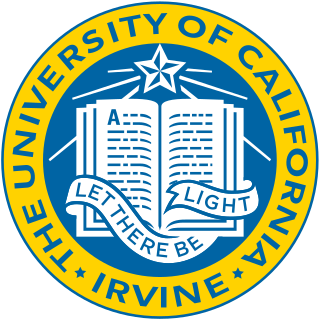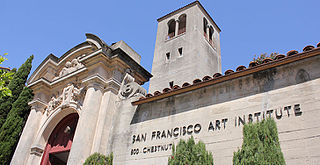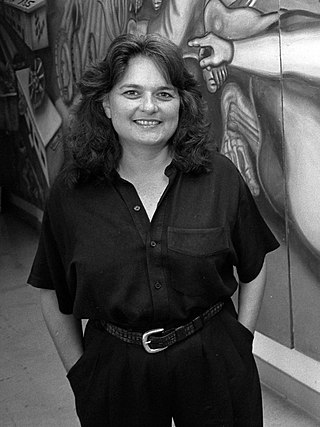New Genres is an artistic movement begun in the early 20th century. The movement is marked by many notable artists who work with a variety of media such as video art, body art, installation, performance, and sound art.
New Genres is an artistic movement begun in the early 20th century. The movement is marked by many notable artists who work with a variety of media such as video art, body art, installation, performance, and sound art.
New Genres art is commonly identified as installation art, video, film, sound, performance, Digital media, internet art, [1] hybrid and other emerging art forms. New Genres is a practice which begins with ideas and then moves to the appropriate form or media for that particular idea, sometimes inventing entirely new sites of cultural production, new methodologies, technologies, or genres in the process. New Genres gives emphasis to questioning preconceived notions of the role of art in culture and its relationship to a specific form or medium. [2]
While no recognized official date marks the beginning of the New Genre period, many[ quantify ] believe that the early 20th-century work of the Dadaists and Futurists initiated this movement. Their work laid a foundation for the experimental practice of New Genres. Duchamp's "Fountain" (1917) introduced the idea of the readymade object: a non-art object which becomes viewed as art due to the intention and designation of the artist. [3] This new use of artistic power and questioning of the art object opened up the conceptual sphere of New Genres. These discoveries illuminated the idea that art was possible outside the field of the classical genres like painting and sculpture.
To understand the movement of New Genres, it is important to look at the events occurring simultaneously in the 20th century.[ citation needed ] In the first half of the century, World War I broke out and caused devastation to much of Eastern Europe. In America, the Great Depression caused a major economic crises that affected many parts of the world. World War II quickly followed, splitting the world into two alliances: the Allies and the Axis. This war caused tremendous damage and introduced new tragedies into the world, such as the Holocaust and the first nuclear weapons.
The San Francisco Art Institute was home to one of the most influential New Genres programs in the United States. [4] The program was started by Howard Fried, who began the program as Performance/Video in the 1970s. Alumni include Karen Finley, Nao Bustamante, and Miguel Calderon, and Rora Blue. Former faculty include Paul Kos, Doug Hall, Tony Labat, Sharon Grace, and Trisha Donnelly.
Several universities have programs in New Genres. These include:

The University of California (UC) is a public land-grant research university system in the U.S. state of California. Headquartered in Oakland, the system is composed of its ten campuses at Berkeley, Davis, Irvine, Los Angeles, Merced, Riverside, San Diego, San Francisco, Santa Barbara, and Santa Cruz, along with numerous research centers and academic centers abroad. The system is the state's land-grant university.

The University of California, Irvine is a public land-grant research university in Irvine, California. One of the ten campuses of the University of California system, UCI offers 87 undergraduate degrees and 129 graduate and professional degrees, and roughly 30,000 undergraduates and 6,000 graduate students were enrolled at UCI as of Fall 2019. The university is classified among "R1: Doctoral Universities – Very high research activity" and had $523.7 million in research and development expenditures in 2021. UCI became a member of the Association of American Universities in 1996.

In European academic traditions, fine art is made primarily for aesthetics or creative expression, distinguishing it from decorative art or applied art, which also has to serve some practical function, such as pottery or most metalwork. In the aesthetic theories developed in the Italian Renaissance, the highest art was that which allowed the full expression and display of the artist's imagination, unrestricted by any of the practical considerations involved in, say, making and decorating a teapot. It was also considered important that making the artwork did not involve dividing the work between different individuals with specialized skills, as might be necessary with a piece of furniture, for example. Even within the fine arts, there was a hierarchy of genres based on the amount of creative imagination required, with history painting placed higher than still life.

San Francisco Art Institute (SFAI) was a private college of contemporary art in San Francisco, California. Founded in 1871, SFAI was one of the oldest art schools in the United States and the oldest west of the Mississippi River. Approximately 220 undergraduates and 112 graduate students were enrolled in 2021. The institution was accredited by the Western Association of Schools and Colleges (WASC) and the National Association of Schools of Art and Design (NASAD), and was a member of the Association of Independent Colleges of Art and Design (AICAD). The school closed permanently in July 2022.
The Los Angeles Westside is an urban region in western Los Angeles County, California, United States. It has no official definition, but sources like LA Weekly and the Mapping L.A. survey of the Los Angeles Times place the region on the western side of the Los Angeles Basin south of the Santa Monica Mountains.

National Taiwan Normal University is a national comprehensive university in Taipei and New Taipei City, Taiwan. The university's predecessor was a normal university.

Otis College of Art and Design is a private art and design school in Los Angeles, California, United States. Established in 1918, it was the city's first independent professional school of art. The main campus is located in the former IBM Aerospace headquarters at 9045 Lincoln Boulevard in Westchester, Los Angeles. The school's programs, accredited by the WSCUC and National Association of Schools of Art and Design, include BFA and MFA degrees.

Judith Francisca Baca is an American artist, activist, and professor of Chicano studies, world arts, and cultures based at the University of California, Los Angeles. She is the co-founder and artistic director of the Social and Public Art Resource Center (SPARC) in Venice, California. Baca is the director of the mural project that created the Great Wall of Los Angeles, which was the largest known communal mural project in the world as of 2018.
Alison Saar is a Los Angeles-based sculptor, mixed-media, and installation artist. Her artwork focuses on the African diaspora and black female identity and is influenced by African, Caribbean, and Latin American folk art and spirituality. Saar is well known for "transforming found objects to reflect themes of cultural and social identity, history, and religion." Saar credits her parents, collagist and assemblage artist Betye Saar and painter and art conservator Richard Saar, for her early exposure to are and to these metaphysical and spiritual practices. Saar followed in her parents footsteps along with her sisters, Lezley Saar and Tracye Saar-Cavanaugh who are also artists. Saar has been a practicing artist for many years, exhibiting in galleries around the world as well as installing public art works in New York City. She has received achievement awards from institutions including the New York City Art Commission as well as the Institute of Contemporary Art in Boston.

Clement Hanami is a Japanese-American artist. He grew up in the predominantly Latino California suburb of East Los Angeles, just outside of downtown. His mother was a hibakusha, or atomic bomb survivor. His father was a World War II incarceree.

Emerson Seville Woelffer, was an American artist and arts educator. He was known as a prominent abstract expressionist artist and painter and taught art at some of the most prestigious colleges and universities. Woelffer was one of the important people in bringing modernism to Los Angeles, when he taught at Chouinard Art Institute.
Barbara Turner Smith is an American artist known for her performance art in the late 1960s, exploring themes of food, nurturing, the body, spirituality, and sexuality. Smith was part of the Feminist Movement in Southern California in the 1970s and has collaborated in her work with scientists and other artists. Her work has been widely exhibited and collected by major museums including the J. Paul Getty Museum, the Hammer Museum, MOCA, LACMA, and the Art Institute of Chicago.

Sholeh Wolpé is an Iranian-born American poet, playwright, librettist, and literary translator. She was born in Iran and grew up there until the age of 13. After that she lived in Trinidad and England during her teenage years before settling in the United States. She lives in Spain and California.
Samuel "Sammy" Hoi is a Hong Kong-born American retired lawyer, academic administrator, and college president. He was the president of Maryland Institute College of Art (MICA) from 2014 until 2023; and the president of Otis College of Art and Design, from 2000 through 2014.
Meg Linton is an American curator of contemporary art and a writer. Her curatorial efforts have ranged from historical investigations such as "Doin’ It in Public: Feminism and Art at the Woman’s Building", "The Los Angeles School: Karl Benjamin, Lorser Feitelson, Frederick Hammersley, June Harwood, Helen Lundeberg, John McLaughlin", and "In the Land of Retinal Delights: The Juxtapoz Factor" to showcasing the work of single artists who are stylistically different such as "Alison Saar: STILL.. .", "Robert Williams: Through Prehensile Eye," and "Joan Tanner: On Tenderhook" to group exhibitions such as "Mexicali Biennial 2010," "Do It Now: Live Green!" and "Tapping the Third Realm."
Robin Gianattassio-Malle is an American journalist and producer specializing in the use of aural and visual media and is founder and executive director of Blue Egg Media, established in 2008.

George Herms is an American artist best known for creating assemblages out of discarded, often rusty, dirty or broken every-day objects, and juxtaposing those objects so as to infuse them with poetry, humor and meaning. He is also known for his works on paper, including works with ink, collage, drawing, paint and poetry. The prolific Herms has also created theater pieces, about which he has said, "I treat it as a Joseph Cornell box big enough that you can walk around in. It's just a continuation of my sculpture, one year at a time." Legendary curator Walter Hopps, who met Herms in 1956, "placed Herms on a dazzling continuum of assemblage artists that includes Pablo Picasso, Kurt Schwitters, Marcel Duchamp, and Joseph Cornell, as well as California luminaries Wallace Berman and Edward Kienholz." Often called a member of the West Coast Beat movement, Herms said that Wallace Berman taught him that "any object, even a mundane cast-off, could be of great interest if contextualized properly." "That’s my whole thing," Herms says. "I turn shit into gold. I just really want to see something I've never seen before." George Herms lives and works in Los Angeles.
Eddo Stern is a California-based artist and developer known for creating experimental video games, game art and machinima-based works. Stern was a founding member of the physical-computing based collective and artist-run space C-Level. He holds a BA in Electronic Media and Art from University of California at Santa Cruz and an MFA in Art and Integrated Media from California Institute of the Arts. A professor at University of California Los Angeles' Design Media Arts program, he is additionally the director of the UCLA Game Lab.
Rebeca Bollinger is an American artist. She works with sculpture, photography, video, drawing, installation, writing and sound.
Gurdon Grant Woods (1915–2007), was an American sculptor, and academic administrator. He served as the director of California School of Fine Arts ; and he founded and chaired the art department at the University of California, Santa Cruz.